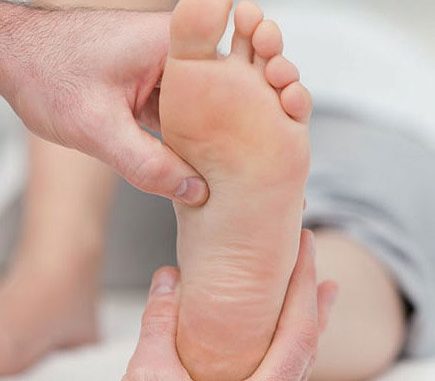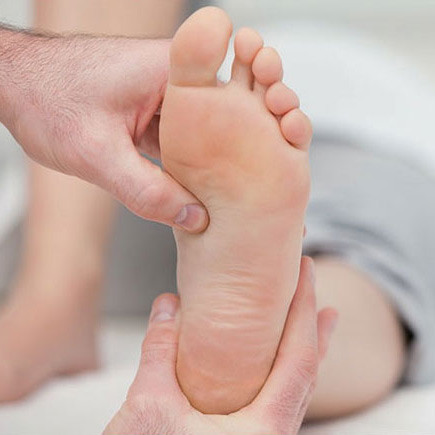
Here are some indicators that your feet are trying to tell you something about your thyroid.
 1. Dry, flaky, cracked, and calloused feet
1. Dry, flaky, cracked, and calloused feet
Hypothyroidism is characterised by an underactive thyroid, and in 2012, researchers set out to investigate the cutaneous (skin) aspects of this condition. Among the 460 people who were diagnosed with hypothyroidism, 300 of them presented with skin that was dry and coarse. This accounts for 65.22 percent of the total.
Another study conducted that same year found that all of the participants with hypothyroidism had skin that was rough, coarse, and dry. Palmoplantar keratoderma is a word that refers to a set of skin disorders that are characterized by a significant thickening of the skin in the palms of the hands and soles of the feet. This issue affects 33% of the population.
The autoimmune disorder that causes hyperthyroidism, often known as an overactive thyroid Graves’ illness, can also manifest itself clinically as having a thicker dermis.
Some symptoms of both hypothyroidism and hyperthyroidism show up in the same way. This may seem like a contradiction, but it happens quite often.
2. itchiness in the feet
Itchy skin is referred to as pruritic in the medical field. Both hyperthyroidism and hypothyroidism have the potential to manifest as chronic pruritus. Itching can occur in many different parts of the body in addition to the feet, including the legs, the scalp, and even the genital area. It is possible that the itching associated with hypothyroidism is due to the extremely dry skin caused by the condition. Researchers believe that pruritus and even chronic urticaria (chronic hives) may be associated with thyroid autoimmunity. Thyroid autoimmunity includes Hashimoto’s thyroiditis and Graves disease (the term Graves disease is used in the United States, whereas the term Basedow’s disease is more commonly used in Europe).
When you get one autoimmune disorder, you are more likely to develop several autoimmune conditions. Because of this, it is essential to point out that the Cleveland Clinic identifies a number of autoimmune disorders as being related to chronic pruritus. Some of these conditions include Sjogren’s syndrome (pronounced SHOW-grins), lichen planus, and psoriasis.
3. Freezing toes and feet
Our extremities, including our feet, are especially susceptible to problems with circulation, particularly during the colder months of the year. Over extended periods of time, it may be necessary to compromise the metabolic requirements of the skin in order to maintain a consistent temperature throughout the body. In a cool setting, when it is necessary for the body to retain its heat, sympathetic impulses cause the vessels of the skin to constrict, and the volume of blood that passes through the skin is noticeably reduced. This helps to ensure that the body’s temperature does not drop.
4. Swollen feet
When a patient comes with swelling of the legs and feet, it is normal practice to investigate the possibilities of heart disease, kidney dysfunction, diabetes, and skin infections as potential causes. Nevertheless, the possibility of hypothyroidism should always be explored. One of the most common symptoms of hypothyroidism is swelling, often known medically as edema. This swelling can occur anywhere on the body.
5. cramping and foot pain
Muscle, joint, and nerve pains are not typically highlighted as key symptoms of hypothyroidism; however, after years of hearing from hypothyroid patients at Hypothyroid Mom, I am certain of one thing.Every single person who complains of chronic pain or fibromyalgia should get comprehensive testing of their thyroid.
There is no way that the number of people who write to Hypothyroid Mom complaining about plantar fasciitis, which is characterised by pain that runs along the bottom of the foot, particularly the heel, and radiates through the person, particularly when they get out of bed in the morning, can be explained by a simple coincidence. In patients suffering from Hashimoto’s thyroiditis or Graves’ disease, the immune system may also attack the joints and muscles, most frequently in the feet and ankles. Patients with thyroid conditions are also more likely to develop tarsal tunnel syndrome, which is similar to carpal tunnel syndrome. When we add to this, the higher chance of getting gout, burning feet from severe neuropathy, and plantar fasciitis, the occurrence of foot pain in thyroid disease becomes extremely evident.

6. A pins-and-needles sensation, tingling, or numbness in the foot
Hypothyroidism can cause symptoms such as paresthesia. The axonal myelin sheath, which is the insulating coating that surrounds nerves, begins to deteriorate when there is not enough thyroid hormone, and the regeneration of damaged nerves also slows down when there is not enough thyroid hormone. There are a number of autoimmune conditions that can manifest themselves as paresthesia, including rheumatoid arthritis, lupus, Sjogren’s syndrome, pernicious anaemia, arthritis, and type 1 diabetes. I would guess that most people who follow Hypothyroid Mom and have been diagnosed with Hashimoto’s thyroiditis or Graves’ disease have more than one autoimmune condition.
7. Infections of the foot
Both hypothyroidism and hyperthyroidism, such as Hashimoto’s thyroiditis and Graves’ disease, are associated with an increased risk of infections of the feet, hands, fingernails, and toenails; these infections include athlete’s foot and onychomycosis.
8. Feet that smell bad
Excessive perspiration, including on the palms of the hands and soles of the feet, is recognised as a classic indicator of hyperthyroidism. Sweat left on the skin provides a fertile environment for the growth of germs, which can result in an unpleasant odour. In most cases, hypothyroidism will lead to a significant decrease in the amount of sweat produced; however, the opposite is also possible, particularly in the instance of Hashimoto’s thyroiditis. In patients with Hashimoto’s disease, it is possible to experience symptoms of both hyperthyroidism and hypothyroidism at the same time. These symptoms include excessive perspiration. When thyroid cells are attacked and destroyed by antibodies, the thyroid hormone that is contained within those cells is released into the blood stream. The symptoms of hyperthyroidism are caused by the sudden increases in thyroid hormone production that happen in people with Hashimoto’s disease. These increases are sometimes called “leaks.”
9. The soles of the feet are yellow
The production of vitamin A from beta-carotene, which is responsible for giving carrots their characteristic orange colour, requires the presence of thyroid hormone. In cases of hypothyroidism, an accumulation of beta-carotene will be deposited in the outermost layer of the skin, which includes the palms of the hands and the soles of the feet.
10. Modifications to the toenails
Both an excess of thyroid hormone as well as a deficiency can lead to abnormalities of the nails, including both the fingernails and the toenails.
Nail changes in hypothyroidism:
- Slow nail growth
- Thick, dry, cracked, brittle nails
- Yellow nails
- Dry cuticles
- Longitudinal ridges
- Onycholysis (separation of nail from nail bed)
- Spoon nails (koilonychia)
Nail changes in hyperthyroidism:
- Fast nail growth
- Pitted and discolored nails
- Absent lunulae (half moons) and cuticles
- Onycholysis (Plummer’s nail)
- Acropahy (clubbing of fingers & toes)
Our feet can tell us a great deal about our thyroid health. They often show obvious signs of disease years and even decades before a thyroid diagnosis.

Leave a Reply